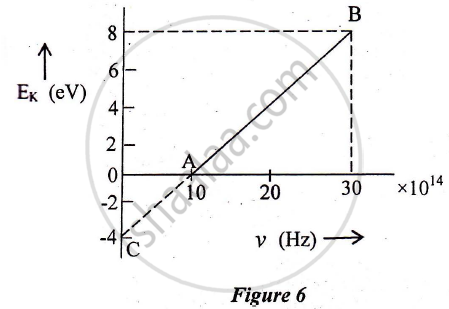Advertisements
Advertisements
प्रश्न
Use Einstein's photoelectric equation to explain the observations from this graph ?
उत्तर
The Einstein's photoelectric equation is \[K_{max} = \frac{1}{2}m \nu^2_{max} = h\nu - \phi_o\]
From the graph, we noticed that
(i) The value of stopping potential is different for radiation of different frequencies.
\[\text { As } \]
\[e V_o = h\nu - \phi_o \]
\[\text { Hence }, V_o \propto \nu\]
(ii) The value of stopping potential is more negative for radiation of higher incident frequency.
APPEARS IN
संबंधित प्रश्न
The photoelectric work function for a metal surface is 2.3 eV. If the light of wavelength 6800A is incident on the surface of metal, find threshold frequency and incident frequency. Will there be an emission of photoelectrons or not?
[Velocity of light c = 3 x 108 m/s,
Planck’s constant, h = 6.63 * 10-34 Js ]
The photoelectric current in a photoelectric cell can be reduced to zero by a stopping potential of 1.8 volt. Monochromatic light of wavelength 2200Å is incident on the cathode. Find the maximum kinetic energy of the photoelectrons in joules. [Charge on electron = 1.6 x 10-19 C]
Draw a neat labelled circuit diagram of experimental arrangement for study of photoelectric effect.
Write three characteristic features in photoelectric effect that cannot be explained on the basis of wave theory of light, but can be explained only using Einstein's equation.
The photoelectric work function for a metal is 4.2 eV. If the stopping potential is 3V, find the threshold wavelength and maximum kinetic energy of emitted electrons.
(Velocity of light in air = 3 x 108m/s,
Planck's constant = 6·63 x10-34 J -s,
Charg.e ori electron = 1·6 x 10 -19 C)
Light of intensity ‘I’ and frequency ‘v’ is incident on a photosensitive surface and causes photoelectric emission. What will be the effect on anode current when (ii) the frequency of incident radiation is increased. In each case, all other factors remain the same. Explain, giving justification in each case.
Draw a plot showing the variation of photoelectric current versus the intensity of incident radiation on a given photosensitive surface.
In an experiment of the photoelectric effect, the graph of maximum kinetic energy EK of the emitted photoelectrons versus the frequency v of the incident light is a straight line AB shown in Figure 6 below:

Find:
1) Threshold frequency of the metal
2) The work function of the metal.
3) Stopping potential for the photoelectrons emitted by the light of frequency `v = 30 xx 10^14 Hz`
Draw a plot showing the variation of photoelectric current with collector potential for different frequencies but same intensity of incident radiation ?
A beam of monochromatic radiation is incident on a photosensitive surface. Answer the following question giving reason :
On what factors does the number of emitted photoelectrons depend?
